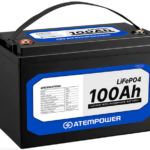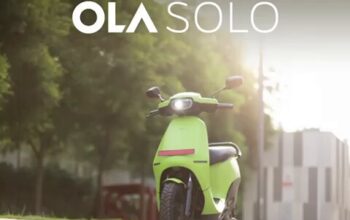The right battery plays an important role in the power supply in the mobile home: Should I buy a lithium battery (LiFePo4) or an AGM battery? Which camper battery (onboard, consumer, supply, body, or second battery) is the right one for my camper electrics? What is the best way to charge the mobile home battery, and what is the difference between a starter and a supply battery? This article will answer all of these questions about RV power supply using batteries.
When planning your mobile home electrical system, you cannot avoid a decent second battery when it comes to the power supply because every camper needs electricity. It doesn’t matter whether you’re charging your laptop or turning on the light: nothing works without electricity. Choosing the right supply battery for the camper electrics is all the more important.
This article deals with the heart of your camper electrics: the supply battery. For this, we look at the following topics:
Why you should never connect your devices to the starter battery.
Where is the difference between an AGM battery and a Lithium (LiFePo4) battery?
How to charge your new mobile home battery using solar, charging booster, and 230V charger.
What is the difference between the starter battery and the supply battery (onboard battery, second battery) in the mobile home?
You can already read the difference in the name: A starter battery is required to start your mobile home. It can produce high currents (needed to start the engine) much better than an onboard battery for a short time. The starter battery is rather unsuitable for supplying constant current like the second battery.
You should never connect your consumers in the mobile home to your starter battery. On the one hand, you damage the battery over a long period, and on the other hand, the risk is too great that your starter battery is suddenly empty, and you can no longer start the engine.
Which battery types are suitable for my motorhome power supply?
There are a total of 4 different RV battery types in the automotive sector: lead-gel, wet, AGM, and lithium (LiFePo4) batteries. In DIY camper conversions, however, only AGM and lithium batteries are often used, which is why we restrict ourselves to these two battery types in this article. But what speaks for an AGM battery, and what are the advantages of a lithium battery?
AGM battery for the camper electrics – advantages and disadvantages in the mobile home
AGM battery – advantages
The biggest advantage of an AGM battery is certainly its low price. An AGM battery costs a fraction of what you would have to pay for a LiFePo4 battery.
AGM batteries can withstand cold much better than lithium-ion batteries
AGM battery – disadvantages
The disadvantage of the AGM battery is the immense loss of performance in the event of deep discharge. Therefore, AGM batteries should never be discharged more than 50%. As a result, you must assume twice the value when calculating your battery capacity.
Double the battery capacity means big and heavy simultaneously, which is another disadvantage of AGM batteries.
Lithium (LiFePo4) Battery for RV Power Supply – Pros and Cons
Advantages Lithium (LiFePO4) battery
The two biggest advantages of a lithium iron phosphate battery are the deep discharge and the longer service life compared to other battery types.
Another important advantage for many: lithium batteries are small and light.
Our 100 Ah lithium battery weighs just 12.3 kg and is 33 cm long. An AGM battery with 230 Ah (since you should only draw 50% of the current) weighs approx. 64 kg and is 52 cm long.
Disadvantages Lithium (LiFePO4) battery
The biggest disadvantage of a lithium battery is certainly the high price.
Another disadvantage of this type of battery is the required modern charging technology. Both your solar controller and your charger must be suitable for LiFePo4 batteries. This may result in (small) additional costs.
Lithium batteries should not be charged below freezing point so they can withstand the cold less than AGM batteries.
AGM battery or LiFePo4 battery? Which battery should I choose for my RV power supply?
Quite simply: If you are more likely to be in extremely cold areas (there are supposed to be), an AGM battery might be the better choice. Use one or more AGM batteries in your motorhome electrical setup if the weight and size are unimportant to you and your camper expansion budget is small. If you don’t have much space and don’t want to replace your batteries in the motorhome every 5 years, it’s better to invest in a LiFePo4 battery. It’s more expensive, but you’ll get more out of it for longer.
How can I charge the supply battery in my mobile home?
Have you selected one or more suitable AGM or lithium (LiFePo4) batteries for your motorhome power supply? Congratulation! Now it’s a matter of putting together the right devices for charging the battery. Because your body battery can be charged in different ways:
Utilizing an alternator and charging booster (optional) while driving
Through a solar system
With shore power (230V) and a suitable charger
Charging the onboard battery with a charging booster or charging converter
In principle, you can charge your onboard batteries in the camper using an alternator and a suitable isolating relay. Your vehicle already uses the alternator to charge the starter battery while driving.
With the help of a cut-off relay, you can connect your starter battery to the body batteries and charge it with the alternator without having to worry about accidentally draining the starter battery as soon as you use electricity in the camper.
However, charging with the alternator takes some time. Especially in newer vehicles from Euro 5, the alternator sometimes switches off after about 30 minutes so that your batteries are no longer charged from this point on.
A charging booster can be worthwhile if you mainly drive short distances and want to pump as much electricity as possible into your batteries while driving. Because charging boosters sometimes work with up to 30A charging current, your batteries are recharged more quickly.
High-quality charging boosters have an intelligent IUoU charging characteristic. They work fully automatically. This means they monitor the voltage of your starter battery and ensure that it is charged first. Only when this voltage is correct does the charging booster automatically charge your supply batteries (similar to the isolating relay). They also adapt their charging characteristics to your battery type and prevent the batteries from being overcharged.
Separating relay versus charging booster: what makes more sense for the power supply in the camper?
Separation relay:
You hardly drive short distances and are almost always at the campsite.
You have an older vehicle with constant voltage from the alternator.
Charging the batteries while driving is just a “nice to have” for you, but not a must.
Charge Booster:
You drive a lot of short trips and want to pump as much electricity into your batteries as possible.
You are often free and want to be able to charge your batteries quickly while driving.
You travel a lot in winter or only use a little solar power to charge your batteries.
You have a newer vehicle from Euro 5 and still want to be able to charge the batteries while driving.
Charge the supply battery using the mobile home solar system
Charging the RV battery using a solar array should not be your primary charging strategy. With an average solar setup, it just takes too long to get your battery full again, as the sun should shine at least 10 hours a day at 100% light intensity, depending on battery capacity, which rarely happens.
A solar system is more worthwhile that you don’t have to drive off immediately or connect 230V when the charging bar of your camper battery goes to zero. Simply put, it eases the situation if you forget to turn off the light in your camper. In this way, you remain self-sufficient for longer and can be free with your camper for longer.
How do I charge the RV consumer battery using solar power?
To charge your supply battery in the mobile home via solar, you need a suitable PWM charge controller connected between the battery and the solar cells. An PWM controller is smarter and, therefore, more effective than a PWM charge controller, even when the sky is cloudy.
Renogy PWM charge controllers have proven their worth. We also have one in use. The smart version with Bluetooth lets you monitor the values at any time using a mobile phone app. It really couldn’t be easier.
What power does the PWM charge controller have to have for my solar system?
That depends entirely on the solar modules used. Example: A Renogy PWM charge controller 75/15 charges your onboard battery with a maximum current of 15A and tolerates a maximum open-circuit voltage of 75V. The open-circuit voltage of your solar modules should normally be stated on the data sheet.
However, you can only connect a maximum of 220 watts to a 75/15 PWM controller at 12V, two 110W portable solar panels for camping. If your modules have more power, the PWM charge controller automatically reduces the wattage. The no-load voltage is also limited to 75V. If you discover that 220W on the roof is not enough for you or that your solar modules have a higher open-circuit voltage, you have to upgrade the charge controller.
It is worth choosing a slightly larger PWM charge controller when planning the electrical system in the camper so that there is still a buffer for later upgrades of the solar modules. We chose a 100/20 PWM controller from Renogy. This is not significantly more expensive than the 75/15 version and offers enough reserve for a solar system upgrade. More details on Renogy charge controllers can be found on the Renogy website.
Charge the mobile home battery with shore power (230V) and a 230V charger
In addition to solar and charging boosters, you can charge your second battery in the motorhome using shore power. However, it would help if you had a suitable charger in your mobile home electrical system. Because depending on whether you decide on an AGM battery or lithium battery, your charger must be equipped with the appropriate charging characteristics.
230V battery chargers are available with different charging currents and voltages (12V and 24V). The higher the charging current, the faster your battery will be fully charged again. However, chargers with higher charging currents are correspondingly more expensive.
You can connect your charger to any normal 230V Schuko socket. Do you want a 230V power supply in the camper anyway? You can use your charger z. B. operate on one of the 230V sockets in your mobile home.
Conclusion
We hope that with this blog post on the topic of “motorhome power supply – battery,” we were able to take away your fear of your first step towards DIY camper electronics.
Related Posts












